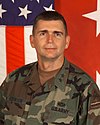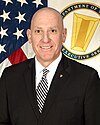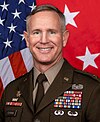United States Army Combat Capabilities Development Command
| U.S. Army Combat Capabilities Development Command | |
|---|---|
 DEVCOM’s distinctive unit insignia | |
| Active | October 2003 – present |
| Country | United States |
| Branch | U.S. Army |
| Role | Research and development |
| Part of | |
| Garrison/HQ | Aberdeen Proving Ground, Maryland |
| Motto(s) | Cum Scientia Commutare ("Through Science We Change.")[1] |
| Website | Official Website |
| Commanders | |
| Current commander | Major General John M. Cushing |
| First commander | Major General Cedric T. Wins[2][3] |
| Insignia | |
| CCDC logo |  |
The Combat Capabilities Development Command, (DEVCOM, aka CCDC) (formerly the United States Army Research, Development, and Engineering Command (RDECOM)) is a subordinate command of the U.S. Army Futures Command. RDECOM was tasked with "creating, integrating, and delivering technology-enabled solutions" to the U.S. Army. It is headquartered at Aberdeen Proving Ground in Maryland.
Role and organization
[edit]CCDC formerly described its role as "the Army's enabling command in the development and delivery of capabilities that empower, unburden and protect the Warfighter."[4] It conducts and sponsors scientific research in areas important to the Army, develops scientific discoveries into new technologies, engineers technologies into new equipment and capabilities, and works with the U.S. Army Training and Doctrine Command to help requirements writers define the future needs of the Army.[5]
CCDC is headquartered at Aberdeen Proving Ground. Before 1 November 2019, Major-General Cedric T. Wins was the commanding general,[2] assisted by Brigadier-General Vincent F. Malone as deputy commanding general and Command Sergeant-Major Jon R. Stanley as command sergeant major. They oversee one laboratory and six major centers:[6]
- US Army CCDC Army Research Laboratory (CCDC ARL) – formerly Army Research Laboratory
- US Army CCDC Chemical Biological Center (CCDC CBC) – formerly Edgewood Chemical Biological Center
- US Army CCDC Soldier Center (CCDC SC) – formerly Natick Soldier Research, Development and Engineering Center
- US Army CCDC Ground Vehicle System Center (CCDC GVSC) – formerly Tank Automotive Research, Development and Engineering Center
- US Army CCDC Aviation & Missile Center (CCDC AvMC) – formerly Aviation and Missile Research, Development and Engineering Center
- US Army CCDC Armaments Center (CCDC AC) – formerly Army Armaments Research, Development and Engineering Center
- US Army CCDC C5ISR Center (CCDC C5ISRC) – formerly Communications-Electronics Research, Development and Engineering Center
History
[edit]After assuming command of the Army Materiel Command in October 2001, General Paul J. Kern saw the need to streamline how the Army developed technology. At the time, the Army's laboratories and research centers reported through multiple channels, among other problems. Kern argued that the Army had to "figure out how to get technology in the hands of the Warfighters quicker" and that it was "the impression of everyone out there that the laboratories take too long, they do science for science's sake, engineering for engineering's sake". Kern proposed to unite the laboratories and research centers under a single command, and the idea was initiated to senior commanders and civilians.[7] The new command was approved, and was provisionally stood up in October 2002, based at Aberdeen Proving Ground where it replaced and integrated the headquarters element of the Soldier and Biological Chemical Command (SBCCOM). In June 2003, RDECOM assumed operational control of the RDE centers. An organizational ceremony took place in October 2003 at Aberdeen Proving Ground, where SBCCOM officially stood down and the 389th Army Band and the Army Material Command's Acquisition Center were assigned to RDECOM. RDECOM became a major subordinate command of the Army Material Command in March 2004, with over 17,000 military, civilian, and contractor personnel at the time. In 2006, the 389th Army Band was designated AMC Band and moved to Redstone Arsenal, Alabama. In 2008, the AMC Acquisition Center became part of the new Army Contracting Command, itself a major subordinate of the AMC. From February 2012 to September 2014, RDECOM was led by a civilian commander, Dale Ormond, before returning to military command.
Transfer to Army Futures Command
[edit]
As of 2018, CCDC reports to Army Futures Command, which will reach full operational capability by August 2019. The new command is focused on readiness for future combat with near-peer competitors, in a shift away from the unconventional, asymmetric warfare fought in various theaters since 2001.
On 4 June 2018, the Headquarters, Department of the Army published General Order 2018–10, "Establishment of the United States Army Futures Command", formally transferring RDECOM from AMC to the new command effective 1 July 2018.[8] The transition of authority from AMC to AFC took place at Aberdeen Proving Ground, MD on 31 January 2019, with a reflagging of the Command and repatching of the commander and CSM.[9]
List of commanding generals
[edit]| No. | Commanding General | Term | |||
|---|---|---|---|---|---|
| Portrait | Name | Took office | Left office | Duration | |
| As U.S. Army Research, Development, and Engineering Command | |||||
| 1 | Major General John C. Doesburg | October 2002 | October 2004 | ~2 years, 0 days | |
| 2 | Major General Roger A. Nadeau | October 2004[10] | July 2007 | ~2 years, 273 days | |
| 3 | Major General Fred D. Robinson Jr. | July 2007[11] | 5 December 2008 | ~1 year, 157 days | |
| 4 | Major General Paul S. Izzo | 5 December 2008[12] | 4 December 2009 | 364 days | |
| 5 | Major General Nick Justice | 4 December 2009[13] | 10 February 2012 | 2 years, 68 days | |
| 6 | Dale A. Ormond | 10 February 2012 | 22 September 2014 | 2 years, 224 days | |
| 7 | Major General John F. Wharton | 22 September 2014[14] | 9 August 2016 | 1 year, 322 days | |
| 8 | Major General Cedric T. Wins | 9 August 2016[15] | 3 February 2019 | 2 years, 178 days | |
| As U.S. Army Combat Capabilities Development Command | |||||
| 1 | Major General Cedric T. Wins | 3 February 2019[9] | 1 November 2019 | 271 days | |
| 2 | Major General John A. George | 1 November 2019[16] | 7 May 2021[17] | 1 year, 187 days | |
| - | John T. Willison Acting | 7 May 2021 | 9 July 2021 | 63 days | |
| 3 | Major General Edmond M. Brown | 9 July 2021[18] | 7 September 2023 | 2 years, 60 days | |
| 4 | Major General John M. Cushing | 7 September 2023[19] | Incumbent | 1 year, 110 days | |
See also
[edit]- United States Marine Corps Warfighting Laboratory (MCWL)
- Naval Research Laboratory (NRL)
- Air Force Research Laboratory (AFRL)
- DARPA
References
[edit]![]() This article incorporates public domain material from websites or documents of the United States Army.
This article incorporates public domain material from websites or documents of the United States Army.
- ^ Distinctive Unit Insignia
- ^ a b "New Commander Arrives at RDECOM". August 2016. Retrieved 13 December 2018.
- ^ Maj. Gen. Cedric T. Wins, U.S. Army Combat Capabilities Development Command (10 September 2019) CCDC'S road map to modernizing the Army: air and missile defense
- Maj. Gen. Cedric T. Wins, U.S. Army Combat Capabilities Development Command (22 Jul 2019) CCDC'S road map to modernizing the Army: Network
- Maj. Gen. Cedric T. Wins, (6 Mar 2019 ) CCDC's Roadmap to modernizing the Army: Future Vertical Lift (FVL)
- Maj. Gen. Cedric T. Wins, (5 December 2018) RDECOM's Roadmap to modernizing the Army: Ground Combat Vehicles
- Maj. Gen. Cedric T. Wins, (25 September 2018) RDECOM's road map to modernizing the Army: Long-range precision fires
- ^ "RDECOM – About". April 2015. Retrieved 13 December 2018.
- ^ "RDECOM Fact Sheet" (PDF). U.S. Army. April 2015. Retrieved 13 December 2018.
- ^ "RDECOM overview". U.S. Army. April 2015. Retrieved 13 December 2018.
- ^ "Life Cycle Management: Integrating Acquisition and Sustainment". 2005. Retrieved 13 December 2018.
- ^ Secretary of the Army, Mark T. Esper, ESTABLISHMENT OF UNITED STATES ARMY FUTURES COMMAND Army General order G.O.2018-10
- ^ a b "RDECOM transitions to Army Futures Command". www.army.mil.
- ^ "Home - General Officer Management Office".
- ^ "PACOM Operational S&T Conference" (PDF). U.S. Army Research, Development and Engineering Command. Retrieved 11 September 2021.
- ^ "RDECOM hails new commander during change of command ceremony". www.army.mil.
- ^ "Maj. Gen. Nick Justice reflects on his tour at RDECOM, APG". www.army.mil.
- ^ "RDECOM welcomes commanding general". www.army.mil.
- ^ "New commander arrives at RDECOM". www.army.mil.
- ^ "CCDC leadership changes hands". www.army.mil.
- ^ "DEVCOM commander retires after 33 years of service". www.army.mil.
- ^ "Brigadier General Brown takes command of DEVCOM". www.army.mil.
- ^ "Brigadier General Cushing takes command of DEVCOM". U.S. Army. 8 September 2023. Retrieved 8 October 2023.












